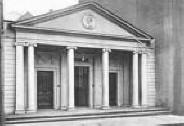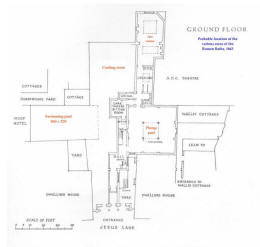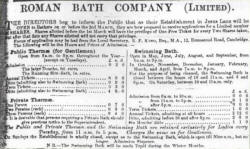3. The Baths

The new building was to be erected on the site of the coach-yard of the Hoop Inn in Bridge Street. In its day, the Hoop had been an important coaching inn, remembered by Wordsworth in his Prelude but, with the decline of coaching, it had become much less busy. The company purchased the yard, and its entrance off Jesus Lane, for the sum of £2,077 which it paid with the help of a mortgage from a Mr Chappell. 11
 The new baths were soon built, their elegant classical portico intended to emphasise that they were Roman in concept and treatment: bathers would not be excessively pummelled by shampooers in
these baths; nor would they find any hot rooms which were steamy or humid.
The new baths were soon built, their elegant classical portico intended to emphasise that they were Roman in concept and treatment: bathers would not be excessively pummelled by shampooers in
these baths; nor would they find any hot rooms which were steamy or humid.
 At present we cannot be absolutely certain where the various areas of the Baths were located. This plan is based on one which shows how the building looked after the alterations made in 1866. The plunge pool and cooling-room are documented as being as shown. The first floor plan shows the position of the furnace chimney tending to confirm that the hot rooms are shown where logically they could only have been. The swimming pool (known to be 56ft long by 22 ft wide) is shown in the only area large enough to contain it.
At present we cannot be absolutely certain where the various areas of the Baths were located. This plan is based on one which shows how the building looked after the alterations made in 1866. The plunge pool and cooling-room are documented as being as shown. The first floor plan shows the position of the furnace chimney tending to confirm that the hot rooms are shown where logically they could only have been. The swimming pool (known to be 56ft long by 22 ft wide) is shown in the only area large enough to contain it.
The main (central) doorway from Jesus Lane led down a passage—likened in one description to a tunnel—directly into the Turkish bath with its cooling-room and plunge pool. 12 On either side was a smaller doorway. The one on the left led to the swimming bath, enabling it to be used independently of the Turkish baths, while the other led to the self-contained two floor flat built for the bath superintendent.
Some of the internal doors are not shown on the plan exactly as they were when the building was first opened and some of the smaller rooms, and possibly the staircase, may well have been different. The door which would have connected the cooling-room to the Turkish baths area would have been blocked up when the premises were let to two different tenants after the baths closed.
The building still stands and, although it is currently a restaurant, its appearance is virtually unchanged
externally. Entering from the street, the main central door opens into a spacious hallway, widened so as to integrate what were originally the three separate entrance passages.
While the interior more closely resembles how it must have looked after Wyatt's alterations (when he let it to the Pitt Club in 1866) it is still quite easy to visualise how the two large dining rooms might have appeared when first built.
Ahead of the entrance hall was the main cooling-room, with
its large central roof light. To the right, a different kind of cooling-room—one with a 12 ft square cold plunge pool, a column at each pool corner supporting the ceiling and
with several lanterns, or roof lights, directly allowing daylight in.
 The pool is waterless now, covered over, and paved to match the still existing original surround.
And looking around the walls, one can still see the decorative metal grilles which
covered the ducts were used to channel warm air into the pool
area.
The pool is waterless now, covered over, and paved to match the still existing original surround.
And looking around the walls, one can still see the decorative metal grilles which
covered the ducts were used to channel warm air into the pool
area.
The baths opened some time between the 21st and 28th of February 1863 and there were advertisements in local newspapers giving details of the opening times and the different types of entrance charge.

This one appeared on 21 February. 13 Even at this late stage, a few days before the opening of the baths, the company was still offering free admission tickets to anyone buying shares before 1 March.
Typically, it seems to have been assumed that anyone living in Cambridge knew what thermae were as no explanation was provided. Neither is there any indication of what the ‘Running Sitz-Bath’ was.
The company's attitude to advertising their new business seems strange. Ads similar to the one above were inserted on very few occasions, just before and after the opening. Afterwards their publicity seems to have been limited to a half inch column in the classified section of each of the two weeklies, but only inserted once a month.
The charging structure tried to take into account every type of user from those wanting a single visit to those preferring term-time or annual subscriptions. By May a female attendant seems to have been appointed to work on Tuesdays, 14 on which day ‘The Public and Private Thermae and the Swimming Bath are retained exclusively for Ladies.’ 13
In April, it was decided that invalids would be allowed to use the baths at half-price, and all members of the town and county police would be admitted free. A couple of months later it was announced that there would be special hours made available for ‘working men.’ 14 There must have been much discussion over this concession; the working men had to bring and use their own towels but whether this was simply to enable the company to offer them the lowest possible price, or for any other reason, is not known.
None of these concessions appears to have helped the company, which must have been struggling financially throughout its short life. Income could not have been high. Apart from the concessionary charges, shareholders with more than 100 shares paid no admission fee at all for their first 52 visits, presumably once a week.
The cost of the land alone would have used most, if not all, the capital raised from the limited sale of shares, there still being just over 80 shareholders in June 1863. The cost of the mortgage on the building and the architects’ fees had to be met, as did the costs of furniture and fittings and, more immediately, staff wages had to be paid.
It therefore seems highly unlikely that there were ever enough bathers to cover running costs, let alone even the most modest of profits.
By December, Cambridge’s grand Roman Baths had already closed, probably hit even harder by the additional cost of their undertaking that ‘The Swimming Bath will be made Tepid during the Winter Months.’
As a last resort, and a somewhat humiliating one, the company, which had so poorly researched its market and had failed to persuade the people of Cambridge to patronise them, now unsuccessfully tried to let the building before it ceased trading at the beginning of 1864.